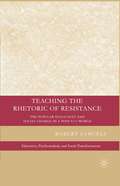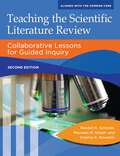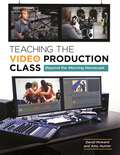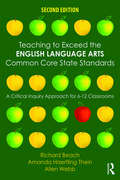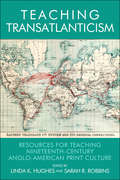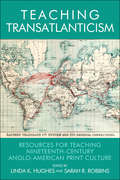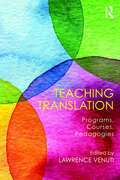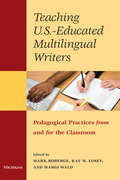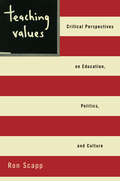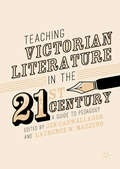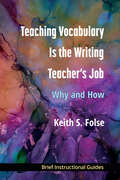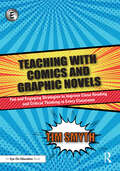- Table View
- List View
Teaching the Postmodern
by Brenda MarshallFirst published in 1992. Routledge is an imprint of Taylor & Francis, an informa company.
Teaching the Rhetoric of Resistance: The Popular Holocaust and Social Change in a Post-9/11 World (Education, Psychoanalysis, and Social Transformation)
by R. SamuelsAnalyzes diverse contemporary reactions to the depiction of the Holocaust and other cultural traumas in museums, movies, television shows, classroom discussions, and bestselling books. This work also describes several effective pedagogical strategies dedicated to overcoming student resistances to critical analysis and social engagement.
Teaching the Scientific Literature Review: Collaborative Lessons for Guided Inquiry (Libraries Unlimited Guided Inquiry)
by Randell K. Schmidt Maureen M. Smyth Virginia K. KowalskiAn essential resource for teachers and librarians who work with students in the later high school years through college and graduate school levels, this book explains and simplifies the scholarly task of researching and writing a scientific literature review.This thoroughly updated and revised follow-up to the popular text Lessons for a Scientific Literature Review: Guiding the Inquiry is designed for pre-collegiate and early collegiate educators in the sciences, high school and college librarians, curriculum directors and common core supervisors, school district leaders, and principals. The book provides step-by-step guidance on instructing students how to perform the necessary research and successfully integrate newly acquired information into a high-quality final product.In addition, you'll find an emphasis on using quantitative science research reports as well as white papers discussing more theoretical science topics, a student timeline for assignments, and a handout specifically for students working on writing a scientific literature review. More than 20 workshops/lessons that are aligned to standards dealing with digital literacy, information handling, research, and textual interpretations and representation are provided. The book allows you to easily adapt it for use of investigation of subjects in the humanities, and for the teaching of an extended essay.
Teaching the Scientific Literature Review: Collaborative Lessons for Guided Inquiry (Libraries Unlimited Guided Inquiry)
by Randell K. Schmidt Maureen M. Smyth Virginia K. KowalskiAn essential resource for teachers and librarians who work with students in the later high school years through college and graduate school levels, this book explains and simplifies the scholarly task of researching and writing a scientific literature review.This thoroughly updated and revised follow-up to the popular text Lessons for a Scientific Literature Review: Guiding the Inquiry is designed for pre-collegiate and early collegiate educators in the sciences, high school and college librarians, curriculum directors and common core supervisors, school district leaders, and principals. The book provides step-by-step guidance on instructing students how to perform the necessary research and successfully integrate newly acquired information into a high-quality final product.In addition, you'll find an emphasis on using quantitative science research reports as well as white papers discussing more theoretical science topics, a student timeline for assignments, and a handout specifically for students working on writing a scientific literature review. More than 20 workshops/lessons that are aligned to standards dealing with digital literacy, information handling, research, and textual interpretations and representation are provided. The book allows you to easily adapt it for use of investigation of subjects in the humanities, and for the teaching of an extended essay.
Teaching the Short Story (Teaching the New English)
by Ailsa CoxThe short story is moving from relative neglect to a central position in the curriculum; as a teaching tool, it offers students a route into many complex areas, including critical theory, gender studies, postcolonialism and genre. This book offers a practical guide to the short story in the classroom, covering all these fields and more.
Teaching the Video Production Class: Beyond the Morning Newscast
by David Howard Amy HunterThis guidebook is a must-have resource for anyone teaching a television production class or running a morning news show at the elementary, middle, or high school level.Teaching a television production class is a real challenge, especially when working with the typical budget and time limitations of most elementary, middle, or high school curricula. Beyond the technical aspects of teaching this subject, what is the best way to keep students engaged and challenged while teaching them skills that will help make them college and career ready? Spanning lesson plans, video production activities, assessment, and more, this book supplies a comprehensive, step-by-step guide to teaching a television production class, using whatever equipment is readily available. It focuses on the critical aspects of how to teach television production and organize lessons, rather than the quickly evolving details of what equipment or editing software to use. The authors also provide lessons on creating and executing a daily newscast show, how to evaluate that show and collect school-wide data for further evaluation and improvement, and how to archive and mount these productions on the school website.
Teaching the Video Production Class: Beyond the Morning Newscast
by David Howard Amy HunterThis guidebook is a must-have resource for anyone teaching a television production class or running a morning news show at the elementary, middle, or high school level.Teaching a television production class is a real challenge, especially when working with the typical budget and time limitations of most elementary, middle, or high school curricula. Beyond the technical aspects of teaching this subject, what is the best way to keep students engaged and challenged while teaching them skills that will help make them college and career ready? Spanning lesson plans, video production activities, assessment, and more, this book supplies a comprehensive, step-by-step guide to teaching a television production class, using whatever equipment is readily available. It focuses on the critical aspects of how to teach television production and organize lessons, rather than the quickly evolving details of what equipment or editing software to use. The authors also provide lessons on creating and executing a daily newscast show, how to evaluate that show and collect school-wide data for further evaluation and improvement, and how to archive and mount these productions on the school website.
Teaching Theory (Teaching the New English)
by Richard BradfordTeaching Theory offers a selection of essays on the pragmatics, benefits and shortcomings of Theory as a key aspect of literature teaching in universities. They range from reflective discussions of Theory as an intellectual challenge for undergraduates to accounts of the day-to-day problems of planning and teaching courses and implementing Theory.
Teaching through Peer Interaction
by Rebecca Adams Rhonda OliverTeaching through Peer Interaction prepares teachers to use peer communication in the classroom. It presents current research of peer interaction and language learning for teachers, including background on the role of peer interaction in classroom language learning, guidelines for adopting and adapting peer interaction opportunities in real classrooms, and perspectives on teachers’ frequently expressed concerns and questions about peer interaction. Practical and comprehensive, this text brings together information on peer communication across the different skill areas, for different learners, in different contexts, and includes discussion on assessment. The text is replete with sample activities, tasks, and instructional sequences to aid teachers' understanding of how to use peer interaction effectively in a range of classroom settings, making it the ideal textbook for upper-level undergraduate and graduate students in language education programs, as well as in-service teachers.
Teaching through Peer Interaction
by Rebecca Adams Rhonda OliverTeaching through Peer Interaction prepares teachers to use peer communication in the classroom. It presents current research of peer interaction and language learning for teachers, including background on the role of peer interaction in classroom language learning, guidelines for adopting and adapting peer interaction opportunities in real classrooms, and perspectives on teachers’ frequently expressed concerns and questions about peer interaction. Practical and comprehensive, this text brings together information on peer communication across the different skill areas, for different learners, in different contexts, and includes discussion on assessment. The text is replete with sample activities, tasks, and instructional sequences to aid teachers' understanding of how to use peer interaction effectively in a range of classroom settings, making it the ideal textbook for upper-level undergraduate and graduate students in language education programs, as well as in-service teachers.
Teaching to Exceed in the English Language Arts: A Justice, Inquiry, and Action Approach for 6-12 Classrooms
by Richard Beach Ashley S. Boyd Allen Webb Amanda Haertling TheinTimely, thoughtful, and comprehensive, this text directly supports pre-service and in-service teachers in developing curriculum and instruction that both addresses and exceeds the requirements of English language arts standards. It demonstrates how the Common Core State Standards as well as other local and national standards’ highest and best intentions for student success can be implemented from a critical, culturally relevant perspective firmly grounded in current literacy learning theory and research. The third edition frames ELA instruction around adopting a justice, inquiry, and action approach that supports students in their schools and community contexts. Offering new ways to respond to current issues and events, the text provides specific examples of teachers employing the justice, inquiry, and action curriculum framework to promote critical engagement and learning. Chapters cover common problems and challenges, alternative models, and theories of language arts teaching. The framework, knowledge, and guidance in this book shows how ELA standards can not only be addressed but also surpassed through engaging instruction to foster truly diverse and inclusive classrooms. The third edition provides new material on: adopting a justice, inquiry, and action approach to enhance student engagement and critical thinking planning instruction to effectively implement standards in the classroom teaching literary and informational texts, with a focus on authors of color integrating drama activities into literature teaching informational, explanatory, argumentative, and narrative writing supporting bilingual/ELL students using digital tools and apps to respond to and create digital texts addressing how larger contextual and political factors shape instruction fostering preservice teacher development
Teaching to Exceed in the English Language Arts: A Justice, Inquiry, and Action Approach for 6-12 Classrooms
by Richard Beach Ashley S. Boyd Allen Webb Amanda Haertling TheinTimely, thoughtful, and comprehensive, this text directly supports pre-service and in-service teachers in developing curriculum and instruction that both addresses and exceeds the requirements of English language arts standards. It demonstrates how the Common Core State Standards as well as other local and national standards’ highest and best intentions for student success can be implemented from a critical, culturally relevant perspective firmly grounded in current literacy learning theory and research. The third edition frames ELA instruction around adopting a justice, inquiry, and action approach that supports students in their schools and community contexts. Offering new ways to respond to current issues and events, the text provides specific examples of teachers employing the justice, inquiry, and action curriculum framework to promote critical engagement and learning. Chapters cover common problems and challenges, alternative models, and theories of language arts teaching. The framework, knowledge, and guidance in this book shows how ELA standards can not only be addressed but also surpassed through engaging instruction to foster truly diverse and inclusive classrooms. The third edition provides new material on: adopting a justice, inquiry, and action approach to enhance student engagement and critical thinking planning instruction to effectively implement standards in the classroom teaching literary and informational texts, with a focus on authors of color integrating drama activities into literature teaching informational, explanatory, argumentative, and narrative writing supporting bilingual/ELL students using digital tools and apps to respond to and create digital texts addressing how larger contextual and political factors shape instruction fostering preservice teacher development
Teaching to Exceed the English Language Arts Common Core State Standards: A Critical Inquiry Approach for 6-12 Classrooms
by Richard Beach Amanda Haertling Thein Allen WebbTimely, thoughtful, and comprehensive, this text directly supports pre-service and in-service teachers in developing curriculum and instruction that both addresses and exceeds the requirements of the Common Core State Standards. Adopting a critical inquiry approach, it demonstrates how the Standards’ highest and best intentions for student success can be implemented from a critical, culturally relevant perspective firmly grounded in current literacy learning theory and research. It provides specific examples of teachers using the critical inquiry curriculum framework of identifying problems and issues, adopting alternative perspectives, and entertaining change in their classrooms to illustrate how the Standards can not only be addressed but also surpassed through engaging instruction. The Second Edition provides new material on adopting a critical inquiry approach to enhance student engagement and critical thinking planning instruction to effectively implement the CCSS in the classroom fostering critical response to literary and informational texts using YA literature and literature by authors of color integrating drama activities into literature and speaking/listening instruction teaching informational, explanatory, argumentative, and narrative writing working with ELL students to address the language Standards using digital tools and apps to respond to and create digital texts employing formative assessment to provide supportive feedback preparing students for the PARCC and Smarter Balanced assessments using the book’s wiki site http://englishccss.pbworks.com for further resources
Teaching to Exceed the English Language Arts Common Core State Standards: A Critical Inquiry Approach for 6-12 Classrooms
by Richard Beach Amanda Haertling Thein Allen WebbTimely, thoughtful, and comprehensive, this text directly supports pre-service and in-service teachers in developing curriculum and instruction that both addresses and exceeds the requirements of the Common Core State Standards. Adopting a critical inquiry approach, it demonstrates how the Standards’ highest and best intentions for student success can be implemented from a critical, culturally relevant perspective firmly grounded in current literacy learning theory and research. It provides specific examples of teachers using the critical inquiry curriculum framework of identifying problems and issues, adopting alternative perspectives, and entertaining change in their classrooms to illustrate how the Standards can not only be addressed but also surpassed through engaging instruction. The Second Edition provides new material on adopting a critical inquiry approach to enhance student engagement and critical thinking planning instruction to effectively implement the CCSS in the classroom fostering critical response to literary and informational texts using YA literature and literature by authors of color integrating drama activities into literature and speaking/listening instruction teaching informational, explanatory, argumentative, and narrative writing working with ELL students to address the language Standards using digital tools and apps to respond to and create digital texts employing formative assessment to provide supportive feedback preparing students for the PARCC and Smarter Balanced assessments using the book’s wiki site http://englishccss.pbworks.com for further resources
Teaching Transatlanticism: Resources for Teaching Nineteenth-Century Anglo-American Print Culture
by Linda Hughes Sarah RobbinsAn essential resource for teaching 19th-century print culture in Transatlantic Studies The 18 chapters in this book outline conceptual approaches to the field and provide practical resources for teaching, ranging from ideas for individual class sessions to full syllabi and curricular frameworks. The book is divided into 5 key sections: Curricular Histories and Key Trends; Organising Curriculum through Transatlantic Lenses; Teaching Transatlantic Figures; Teaching Genres in Transatlantic Context; and Envisioning Digital Transatlanticism. Individual chapters from experts in the field range from reconceptualising entire courses to revisiting individual texts, authors, and genres in a transatlantic context. Weaving in strategies from innovative teaching shaped by the digital humanities, the collection also looks ahead to the future of this growing field.
Teaching Transatlanticism: Resources for Teaching 19th-Century Anglo-American Print Culture
by Linda Hughes Sarah RobbinsAn essential resource for teaching 19th-century print culture in Transatlantic Studies The 18 chapters in this book outline conceptual approaches to the field and provide practical resources for teaching, ranging from ideas for individual class sessions to full syllabi and curricular frameworks. The book is divided into 5 key sections: Curricular Histories and Key Trends; Organising Curriculum through Transatlantic Lenses; Teaching Transatlantic Figures; Teaching Genres in Transatlantic Context; and Envisioning Digital Transatlanticism. Individual chapters from experts in the field range from reconceptualising entire courses to revisiting individual texts, authors, and genres in a transatlantic context. Weaving in strategies from innovative teaching shaped by the digital humanities, the collection also looks ahead to the future of this growing field.
Teaching Translation: Programs, courses, pedagogies
by Lawrence VenutiOver the past half century, translation studies has emerged decisively as an academic field around the world, and in recent years the number of academic institutions offering instruction in translation has risen along with an increased demand for translators, interpreters and translator trainers. Teaching Translation is the most comprehensive and theoretically informed overview of current translation teaching. Contributions from leading figures in translation studies are preceded by a substantial introduction by Lawrence Venuti, in which he presents a view of translation as the ultimate humanistic task – an interpretive act that varies the form, meaning, and effect of the source text. 26 incisive chapters are divided into four parts, covering: certificate and degree programs teaching translation practices studying translation theory, history, and practice surveys of translation pedagogies and key textbooks The chapters describe long-standing programs and courses in the US, Canada, the UK, and Spain, and each one presents an exemplary model for teaching that can be replicated or adapted in other institutions. Each contributor responds to fundamental questions at the core of any translation course – for example, how is translation defined? What qualifies students for admission to the course? What impact does the institutional site have upon the course or pedagogy? Teaching Translation will be relevant for all those working and teaching in the areas of translation and translation studies. Additional resources for Translation and Interpreting Studies are available on the Routledge Translation Studies Portal.
Teaching Translation: Programs, courses, pedagogies
by Lawrence VenutiOver the past half century, translation studies has emerged decisively as an academic field around the world, and in recent years the number of academic institutions offering instruction in translation has risen along with an increased demand for translators, interpreters and translator trainers. Teaching Translation is the most comprehensive and theoretically informed overview of current translation teaching. Contributions from leading figures in translation studies are preceded by a substantial introduction by Lawrence Venuti, in which he presents a view of translation as the ultimate humanistic task – an interpretive act that varies the form, meaning, and effect of the source text. 26 incisive chapters are divided into four parts, covering: certificate and degree programs teaching translation practices studying translation theory, history, and practice surveys of translation pedagogies and key textbooks The chapters describe long-standing programs and courses in the US, Canada, the UK, and Spain, and each one presents an exemplary model for teaching that can be replicated or adapted in other institutions. Each contributor responds to fundamental questions at the core of any translation course – for example, how is translation defined? What qualifies students for admission to the course? What impact does the institutional site have upon the course or pedagogy? Teaching Translation will be relevant for all those working and teaching in the areas of translation and translation studies. Additional resources for Translation and Interpreting Studies are available on the Routledge Translation Studies Portal.
Teaching U.S.-Educated Multilingual Writers: Pedagogical Practices from and for the Classroom
by Roberge Mark Losey Kay M. Wald MargiThis volume was born to address the lack of classroom-oriented scholarship regarding U.S.-educated multilingual writers. Unlike prior volumes about U.S.-educated multilinguals, this book focuses solely on pedagogy--from classroom activities and writing assignments to course curricula and pedagogical support programs outside the immediate classroom. Unlike many pedagogical volumes that are written in the voice of an expert researcher-theorist, this volume is based on the notion of teachers sharing practices with teachers. All of the contributors are teachers who are writing about and reflecting on their own experiences and outcomes and interweaving those experiences and outcomes with current theory and research in the field. The volume thus portrays teachers as active, reflective participants engaged in critical inquiry. Contributors represent community college, college, and university contexts; academic ESL, developmental writing, and first-year composition classes; and face-to-face, hybrid, and online contexts. This book was developed primarily to meet the needs of practicing writing teachers in college-level ESL, basic writing, and college composition classrooms, but will also be useful to pre-service teachers in TESOL, Composition, and Education graduate programs.
Teaching Values: Critical Perspectives on Education, Politics, and Culture
by Ron ScappIn Teaching Values, Ron Scapp wrests the discussion of values and values-based education away from traditionalists who have long dominated educational debates. While challenging the Right's domination of the discussion of values education, Scapp examines some issues not typically raised by educators and critics on the Left, including the positive role of citizenship and national identity in U.S. education and culture.
Teaching Values: Critical Perspectives on Education, Politics, and Culture
by Ron ScappIn Teaching Values, Ron Scapp wrests the discussion of values and values-based education away from traditionalists who have long dominated educational debates. While challenging the Right's domination of the discussion of values education, Scapp examines some issues not typically raised by educators and critics on the Left, including the positive role of citizenship and national identity in U.S. education and culture.
Teaching Victorian Literature in the Twenty-First Century
by Jen Cadwallader Laurence W MazzenoThis edited collection offers undergraduate Literature instructors a guide to the pedagogy and teaching of Victorian literature in liberal arts classrooms. With numerous essays focused on thematic course design, this volume reflects the increasingly interdisciplinary nature of the literature classroom. A section on genre provides suggestions on approaching individual works and discussing their influence on production of texts. Sections on digital humanities and "out of the classroom" approaches to Victorian literature reflect current practices and developing trends. The concluding section offers three different versions of an "ideal" course, each of which shows how thematic, disciplinary, genre, and technological strands may be woven together in meaningful ways. Professors of introductory literature courses aimed at non-English majors to advanced seminars for majors will find accessible and innovative course ideas supplemented with a variety of versatile teaching materials, including syllabi, assignments, and in-class activities.
Teaching Victorian Literature in the Twenty-First Century: A Guide to Pedagogy (PDF)
by Jen Cadwallader Laurence W MazzenoThis edited collection offers undergraduate Literature instructors a guide to the pedagogy and teaching of Victorian literature in liberal arts classrooms. With numerous essays focused on thematic course design, this volume reflects the increasingly interdisciplinary nature of the literature classroom. A section on genre provides suggestions on approaching individual works and discussing their influence on production of texts. Sections on digital humanities and “out of the classroom” approaches to Victorian literature reflect current practices and developing trends. The concluding section offers three different versions of an “ideal” course, each of which shows how thematic, disciplinary, genre, and technological strands may be woven together in meaningful ways. Professors of introductory literature courses aimed at non-English majors to advanced seminars for majors will find accessible and innovative course ideas supplemented with a variety of versatile teaching materials, including syllabi, assignments, and in-class activities.
Teaching Vocabulary Is the Writing Teacher's Job: Why and How
by Keith S. FolseWhile most teachers acknowledge the importance of vocabulary in learning a new language, many assume a reading class or other teacher will cover vocabulary. Yet vocabulary plays an essential role in good writing, especially academic writing. Teaching Vocabulary Is the Writing Teacher’s Job explores the serious nature of ESL students’ lexical plight and looks at vocabulary in relation to reading, speaking, listening, and writing proficiency. It also examines the role of vocabulary in ESL writing assessment. In the conclusion, author Keith Folse discusses eight research-based suggestions for writing teachers, including encouraging students to become vocabulary detectives, teaching collocations, testing vocabulary, and teaching paraphrasing and summarizing.
Teaching with Comics and Graphic Novels: Fun and Engaging Strategies to Improve Close Reading and Critical Thinking in Every Classroom
by Tim Smyth35th Annual Will Eisner Comic Industry Awards Nominee! This text will allow you to harness students’ love of comics and graphic novels while increasing critical thinking and engagement in the classroom. Author Tim Smyth offers a wide variety of lessons and ideas for using comics to teach close reading, working with textual evidence, literature adaptations, symbolism and culture, sequencing, essay writing, and more. He also models how to use comics to tackle tough topics and enhance social-emotional learning. Throughout the book, you’ll find a multitude of practical resources, including a variety of lesson plans—some quick and easy activities as well as more detailed ready-to-use unit plans. These thoughtful lessons meet the Common Core State Standards and are easy to adapt for any subject area or grade level to fit into your curriculum. Add this book to your professional library and you’ll have a new and exciting way of reaching and teaching your students!

